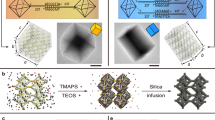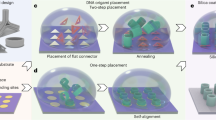Abstract
DNA nanotechnology1,2 and particularly DNA origami3, in which long, single-stranded DNA molecules are folded into predetermined shapes, can be used to form complex self-assembled nanostructures4,5,6,7,8,9,10. Although DNA itself has limited chemical, optical or electronic functionality, DNA nanostructures can serve as templates for building materials with new functional properties. Relatively large nanocomponents such as nanoparticles and biomolecules can also be integrated into DNA nanostructures and imaged11,12,13. Here, we show that chemical reactions with single molecules can be performed and imaged at a local position on a DNA origami scaffold by atomic force microscopy. The high yields and chemoselectivities of successive cleavage and bond-forming reactions observed in these experiments demonstrate the feasibility of post-assembly chemical modification of DNA nanostructures and their potential use as locally addressable solid supports.
This is a preview of subscription content, access via your institution
Access options
Subscribe to this journal
Receive 12 print issues and online access
$259.00 per year
only $21.58 per issue
Buy this article
- Purchase on Springer Link
- Instant access to full article PDF
Prices may be subject to local taxes which are calculated during checkout



Similar content being viewed by others
References
Seeman, N. C. An overview of structural DNA nanotechnology. Mol. Biotechnol. 37, 246–257 (2007).
Gothelf, K. V. & LaBean, T. H. DNA-programmed assembly of nanostructures. Org. Biomol. Chem. 23, 4023–4037 (2005).
Rothemund, P. W. K. Folding DNA to create nanoscale shapes and patterns. Nature 440, 297–302 (2006).
Qian, L. et al. Analogic China map constructed by DNA. Chin. Sci. Bull. 51, 2973–2976 (2006).
Andersen, E. S. et al. DNA origami design of dolphin-shaped structures with flexible tails. ACS Nano 2, 1213–1218 (2008).
Andersen, E. S. et al. Self-assembly of a nanoscale DNA box with a controllable lid. Nature 459, 73–76 (2009).
Ke, Y. et al. Scaffolded DNA origami of a DNA tetrahedron molecular container. Nano Lett. 9, 2445–2447 (2009).
Kuzuya, A. & Komiyama, M. Design and construction of a box-shaped 3D-DNA origami. Chem. Commun. 4182–4184 (2009).
Douglas, S. M. et al. Self-assembly of DNA into nanoscale three-dimensional shapes. Nature 459, 414–418 (2009).
Dietz, H., Douglas, S. M. & Shih, W. M. Folding DNA into twisted and curved nanoscale shapes. Science 325, 725–730 (2009).
LaBean, T. & Li, H. Using DNA for construction of novel materials. Nano Today 2, 26–35 (2007).
Rinker, S., Ke, Y., Liu, Y., Chhabra, R. & Yan, H. Self-assembled DNA nanostructures for distance-dependent multivalent ligand–protein binding. Nature Nanotech. 3, 418–422 (2008).
Ke, Y., Lindsay, S., Chang, Y., Liu, Y. & Yan, H. Self-assembled water-soluble nucleic acid probe tiles for label-free RNA hybridization assays. Science 319, 180–183 (2008).
Chhabra, R. et al. Spatially addressable multiprotein nanoarrays templated by aptamer-tagged DNA nanoarchitectures. J. Am. Chem. Soc. 129, 10304–10305 (2007).
Yan, H., Park, S. H., Finkelstein, G., Reif, J. & LaBean, T. H. DNA-templated self-assembly of protein arrays and highly conductive nanowires. Science 301, 1882–1884 (2003).
Lund, K., Liu, Y., Lindsay, S. & Yan, H. Self-assembling a molecular pegboard. J. Am. Chem. Soc. 127, 17606–17607 (2005).
Park, S.-H. K. et al. Finite-size, fully addressable DNA tile lattices formed by hierarchical assembly procedures. Angew. Chem. Int. Ed. 45, 735–739 (2006).
Park, S.-H. et al. Programmable DNA self-assemblies for nanoscale organization of ligands and proteins. Nano Lett. 5, 729–733 (2005).
Kuzuya, A. et al. Precisely programmed and robust 2D streptavidin nanoarrays by using periodical nanometer-scale wells embedded in DNA origami assembly. ChemBioChem 10, 1811–1815 (2009).
Kuzyk, A., Laitinen, K. T. & Törmä, P. DNA origami as a nanoscale template for protein assembly. Nanotechnology 20, 235305 (2009).
Baugh, S. D. P., Yang, Z., Leung, D. K., Wilson, D. M. & Breslow, R. Cyclodextrin dimers as cleavable carriers of photodynamic sensitizers. J. Am. Chem. Soc. 123, 12488–12494 (2001).
Rotaru, A. & Mokhir, A. Nucleic acid binders activated by light of selectable wavelength. Angew. Chem. Int. Ed. 46, 6180–6183 (2007).
Tornøe, C. W., Christensen, C. & Meldal, M. Peptidotriazoles on solid phase: [1,2,3]-triazoles by regiospecific copper(i)-catalyzed 1,3-dipolar cycloadditions of terminal alkynes to azides. J. Org. Chem. 67, 3057–3064 (2002).
Rostovtsev, V. V., Green, L. G., Fokin, V. V. & Sharpless, K. B. A stepwise huisgen cycloaddition process: copper(I)-catalyzed regioselective ‘ligation’ of azides and terminal alkynes. Angew. Chem. Int. Ed. 41, 2596–2599 (2002).
Chan, T. R., Hilgraf, R., Sharpless, K. B. & Fokin, V. V. Polytriazoles as copper(I)-stabilizing ligands in catalysis. Org. Lett. 6, 2853–2855 (2004).
van Kasteren, I. et al. Expanding the diversity of chemical protein modification allows post-translational mimicry. Nature 446, 1105–1109 (2007).
Schweitzer, C. & Schmidt, R. Physical mechanisms of generation and deactivation of singlet oxygen. Chem. Rev. 103, 1685–1758 (2003).
Gothelf, K. V. et al. Modular DNA-programmed assembly of linear and branched conjugated nanostructures. J. Am. Chem. Soc. 126, 1044–1046 (2004).
Andersen, C. S., Yan, H. & Gothelf, K. V. Bridging one helical turn in double-stranded DNA by templated dimerization of molecular rods. Angew. Chem. Int. Ed. 47, 5569–5572 (2008).
Acknowledgements
The authors would like to thank V. Birkedal and T. LaBean for valuable comments regarding the manuscript. This work was supported by grants from the Danish National Research Foundation to the CDNA centre and the Danish Research Agency through support for the iNANO Center.
Author information
Authors and Affiliations
Contributions
N.V.V., T.T. and A.R. contributed equally to the design and execution of the experiments. M.F.J. and J.B.R. synthesized some of the organic compounds. R.S. and W.M. assisted in the AFM imaging. A.M. provided Linker C. J.K. and F.B. advised on the project. K.V.G. directed the project and co-wrote the manuscript. All authors discussed the results and commented on the manuscript.
Corresponding author
Ethics declarations
Competing interests
The authors declare no competing financial interests.
Supplementary information
Supplementary information
Supplementary information (PDF 3654 kb)
Rights and permissions
About this article
Cite this article
Voigt, N., Tørring, T., Rotaru, A. et al. Single-molecule chemical reactions on DNA origami. Nature Nanotech 5, 200–203 (2010). https://doi.org/10.1038/nnano.2010.5
Received:
Accepted:
Published:
Issue Date:
DOI: https://doi.org/10.1038/nnano.2010.5
This article is cited by
-
Fabricating higher-order functional DNA origami structures to reveal biological processes at multiple scales
NPG Asia Materials (2023)
-
Site-directed placement of three-dimensional DNA origami
Nature Nanotechnology (2023)
-
Functionalizing DNA origami to investigate and interact with biological systems
Nature Reviews Materials (2022)
-
DNA origami
Nature Reviews Methods Primers (2021)
-
Hybrid material of structural DNA with inorganic compound: synthesis, applications, and perspective
Nano Convergence (2020)



